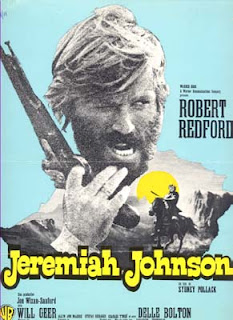Jeremiah Johnson
 In 1972 Sydney Pollack reteamed with Robert Redford for Jeremiah Johnson, the tale of a man who leaves civilization behind to trap and live off the land in the Rocky Mountains. The only difference was that by this time Redford was a huge star. His persona dominates the picture, but I've learned in the last few days that Pollack's imprint is also on the picture in ways I didn't realize.
In 1972 Sydney Pollack reteamed with Robert Redford for Jeremiah Johnson, the tale of a man who leaves civilization behind to trap and live off the land in the Rocky Mountains. The only difference was that by this time Redford was a huge star. His persona dominates the picture, but I've learned in the last few days that Pollack's imprint is also on the picture in ways I didn't realize.Of course, everyone knows that Redford is a keen environmentalist and lives on a large ranch in Utah. In fact, much of Jeremiah Johnson was filmed on that ranch, so in essence it was shot in his backyard. But I didn't know that Pollack also had a home at Sundance, and shared Redford's enthusiasms, so the result is a labor of love that is also a fine Western.
There is no backstory for Johnson, we meet him as he is outfitting for his life change. We know that he was a veteran in the Mexican War by the uniform pants he wears, but beyond that we are clueless, and this adds a nice air of mystery to the film. He has some skills (certainly more than Chris McCandless in Into the Wild) but is green in some areas. He is helped immeasurably when he runs into another mountain man, played in enjoyably crusty fashion by Will Geer.
Johnson wants to be alone, but ends up with a de facto family when he takes on a boy who is the sole survivor of an Indian massacre, and then manages to get himself married to a squaw (he is told by another trapper that to refuse the gift of a chief's daughter would be an insult that would prove fatal). Johnson finds he enjoys the company, and builds a cabin for the three of them to settle down. But wouldn't you know, a company of U.S. bluecoats come through and their actions upset the balance of respect that Johnson had had with the local Indians and his idyll gets shattered.
Though the film has an underlying feel of 197os do-goodism, it still holds up as a solid entertainment. Redford is very good at this sort of thing, the stoic loner who only reluctantly forms relationships. Aside from a few drippy songs, the production could have come from any time period. Pollack's direction is no-nonsense and makes excellent use of the beautiful terrain, photographed by Duke Callaghan. Also notably, the film does not make blanket apologies to treatment of American Indians. They are depicted as most humanity should be--there are some good ones, and some bad ones.


Again I agree with JS on his assessment of this Pollack film; it's an excellent film and hard to believe that the same director/star combo would make the abysmal TWWW just a year later.
ReplyDeleteUsually these types of rugged rural outdoor films aren't really my cup of tea but I found this superbly entertaining throughout.
An interesting thing about the ending; I won't give away what the final scene is but I read years ago Pollack saying that another ending was originally intended.
It was going to be a replica of a very early scene where Redford comes across a man frozen to death (with a note pinned to him which says to take his gun; which Jeremiah does). On this occasion Jeremiah would be the one frozen to death but Pollack felt it was too pretentious and hence we have the somewhat more ambiguous ending.